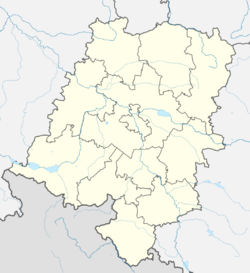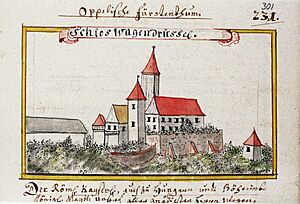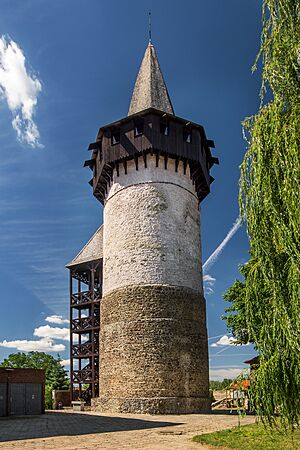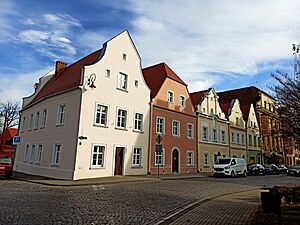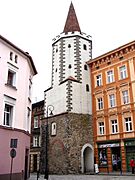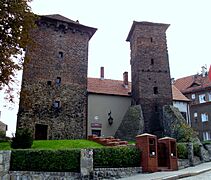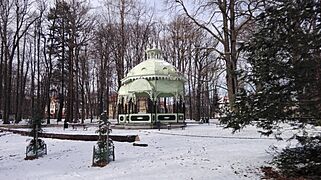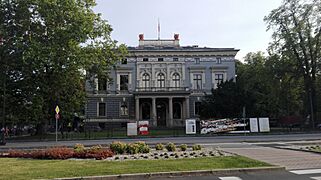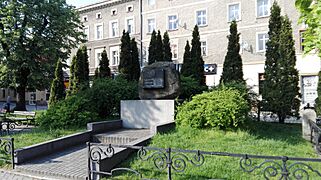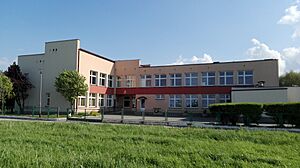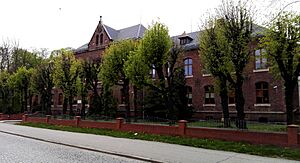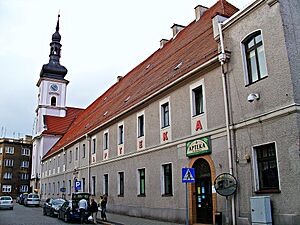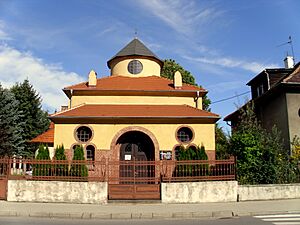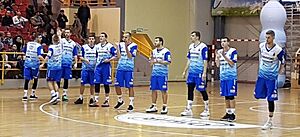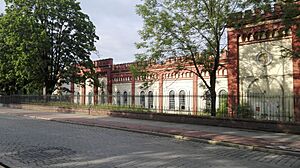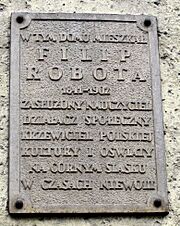Prudnik facts for kids
Quick facts for kids
Prudnik
|
|||||
|---|---|---|---|---|---|
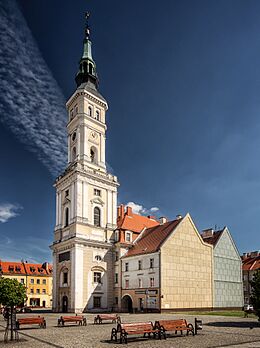
Historic Town Hall on the Market Square
|
|||||
|
|||||
| Motto(s):
Prudnik – spotkajmy się (Polish "Prudnik – let's meet")
|
|||||
| Country | |||||
| Voivodeship | |||||
| County | Prudnik County | ||||
| Gmina | Gmina Prudnik | ||||
| Founded | 1255/1259 | ||||
| Town rights | 1279 | ||||
| Area | |||||
| • Total | 20.50 km2 (7.92 sq mi) | ||||
| Elevation | 265 m (869 ft) | ||||
| Population
(2019-06-30)
|
|||||
| • Total | 21,041 | ||||
| • Density | 1,026.39/km2 (2,658.3/sq mi) | ||||
| Time zone | UTC+1 (CET) | ||||
| • Summer (DST) | UTC+2 (CEST) | ||||
| Postal code |
48–200
|
||||
| Car plates | OPR | ||||
| National roads | |||||
| Voivodeship roads | |||||
| Website | http://www.prudnik.pl | ||||
Prudnik is a town in southern Poland. It's located in the Opole Voivodeship, close to the border with the Czech Republic. Prudnik is the main town of Prudnik County and Gmina Prudnik. About 21,000 people live here. Since 2015, Prudnik has been part of Cittaslow International, a group of towns that want to improve quality of life and slow down the pace of modern life.
The town was founded around 1250. It has been part of different countries throughout history, including Poland, Austria, Prussia, and Germany, before becoming part of Poland again. Prudnik was once famous for making shoes and, more recently, towels. The company ZPB "Frotex" was one of Europe's largest towel makers. The town also has many old buildings, like the Prudnik Town Hall and "Wok's Tower," which is from the 13th century. The name "Prudnik" comes from a Polish word meaning "fast stream," referring to the Prudnik river.
Contents
Geography
Prudnik is located in the historic Silesia region, where the Prudnik river meets its Złoty Potok branch. The town sits between the Opawskie Mountains and the flat area called the Prudnik Depression. Prudnik and Vrbno pod Pradědem (in the Czech Republic) are the main centers of the Euroregion Praděd, which helps different areas work together.
History
Early Times
People have lived in the Prudnik area since the Paleolithic (Stone Age). Ancient Slavs living here traded with Rome, as shown by Roman coins found in the area.
Middle Ages
Between 1255 and 1259, a Czech knight named Wok of Rosenberg built a castle by the Prudnik river. His son, Jindřich, helped the town get its official town rights in 1279. In 1337, Prudnik became part of the Duchy of Opole, ruled by Polish dukes from the Piast dynasty. It stayed Polish until 1532, when it became part of the Austrian-ruled Bohemian Crown. Prudnik was an important stop on a trade route between Wrocław and Vienna.
The oldest known design of Prudnik's coat of arms is from a 1399 seal. A knight from Prudnik named Maćko fought alongside Polish troops in the Battle of Grunwald in 1410.
Later History
In 1564, Jewish people were asked to leave Prudnik, but some were allowed to stay until 1570. During the Thirty Years' War, Swedish soldiers captured and robbed the town in 1632. In 1645, Prudnik returned to Polish rule under the House of Vasa, but in 1666, it became part of Austria again.
In 1742, Prudnik became part of Prussia. During the Seven Years' War, there was a surprise attack on Prussian troops near Prudnik in 1760. The town then grew into a major center for making cloth and shoes. In the 19th century, factories continued these traditions.
World Wars and Modern Times
Prudnik remained part of Germany after Poland became independent in 1918. However, Polish groups still worked in the town. In 1938, Adolf Hitler visited Prudnik. During World War II, the Germans set up forced labor camps in Prudnik. A subcamp of the Auschwitz concentration camp was also here, where about 400 women were held. In 1945, these prisoners were forced to march to another camp. The town was also a stopping point for thousands of other prisoners on "death marches" from other camps. The Red Army captured Prudnik on March 18, 1945.
After World War II in 1945, Prudnik became part of Poland again. Its original Polish name, Prądnik, was used, and then changed to Prudnik in 1946. Unlike some other areas, many local people in Prudnik who spoke a mix of Polish and German were allowed to stay if they declared themselves Polish. Many Polish settlers also came to Prudnik from other parts of Poland. Today, Prudnik and its surroundings are known for having a German minority.
In September 1980, about 1500 workers from the ZPB "Frotex" factory and firefighters in Prudnik went on a big strike against the communist government. This strike lasted five days. In 2024, Prudnik was flooded, which damaged some historic buildings and bridges.
Historical population
|
|
|
Sights
Prudnik has many interesting old buildings and places to see:
- The medieval Wok's Tower, which is what's left of the old castle.
- Parts of the old town walls, including the Lower Gate and the Katowska and Mała towers. These are now part of the local historical museum.
- The Prudnik Town Hall, built in the Baroque and Classicist styles.
- The Baroque St. Michael's Church.
- The Baroque Saints Peter and Paul Church.
- The Park Miejski (Town Park) with a statue of Diana. There are also monuments to Polish activists and a monument celebrating 1000 years of the Polish State.
- The Prudnik Culture Centre.
- The public Town Bath.
- The St. Joseph Church.
- World War II memorials, including one for Polish children and youth who were heroes and victims of the war. There are also two mass graves for prisoners from the Nazi German Auschwitz concentration camp who died in the town in 1945.
- Baroque statues like the Marian column and the Saint John of Nepomuk statue.
Education
Preschools
- Publiczne Przedszkole nr 1 (5 Mickiewicza Street)
- Zespół Szkolno-Przedszkolny nr 2 (12 Szkolna Street)
- Publiczne Przedszkole nr 3 (69 Piastowska Street)
- Publiczne Przedszkole nr 4 (9 Mickiewicza Street)
- Publiczne Przedszkole Specjalne nr 5 (1 Młyńska Street)
- Publiczne Przedszkole nr 6 (9a Podgórna Street)
- Publiczne Przedszkole nr 8 (1 Ogrodowa Street)
- Niepubliczne Przedszkole "Skrzat" (66 Grunwaldzka Street)
Primary schools
- Publiczna Szkoła Podstawowa nr 1 (9 Podgórna Street)
- Zespół Szkolno-Przedszkolny nr 2 (12 Szkolna Street)
- Publiczna Szkoła Podstawowa nr 3 (12 Szkolna Street)
- Publiczna Szkoła Podstawowa nr 4 (2 Dąbrowskiego Street)
- Publiczna Szkoła Podstawowa Specjalna nr 5 (1 Młyńska Street)
Secondary schools
- Publiczne Gimnazjum nr 1 (1 Armii Krajowej Street)
- Publiczne Gimnazjum nr 2 (2 Dąbrowskiego Street)
- Publiczne Gimnazjum Specjalne nr 3 (1 Młyńska Street)
High schools
- I Liceum Ogólnokształcące (2 Gimnazjalna Street)
- II Liceum Ogólnokształcące (55 Kościuszki Street)
- Liceum Ogólnokształcące dla dorosłych (5 Podgórna Street)
- Zespół Szkół Medycznych (Medical School) (26 Piastowska Street)
- Zespół Szkół Rolniczych (76 Kościuszka Street)
- Zespół Szkół Zawodowych (5 Podgórna Street)
- Państwowa Szkoła Muzyczna I st. (36 Traugutta Street)
- Szkoła policealna dla dorosłych (26 Piastowska Street)
Religion
Churches and Religious Groups
- Catholic Church
- Saint Michael the Archangel parish (Plac Farny 2)
- Saint Michael the Archangel church (Plac Farny 2)
- Saints Peter and Paul church (6 Piastowska Street)
- Saint Joseph church (Prudnik-Las, 5 Józefa Poniatowskiego Street)
- Divine Mercy parish (35 Skowrońskiego Street)
- Divine Mercy church (35 Skowrońskiego Street)
- Saint Michael the Archangel parish (Plac Farny 2)
- Pentecostal Church
- Zbór Syloe (40A Kolejowa Street)
- Jehovah's Witnesses
- zbór Prudnik (Kingdom Hall, 22A Piastowska Street)
Cemeteries
- Cmentarz Komunalny (19 Kościuszki Street)
- Jewish cemetery (40 Kolejowa Street)
Sport
Sports Venues
- Football pitch (Kolejowa 7)
- Football pitch (Włoska 10)
- Sports Hall "Obuwnik"
- Orlik 2012 field (a type of multi-sport pitch)
- Summer swimming pool
Sports Teams
- KS Pogoń Prudnik (basketball)
- MKS Pogoń Prudnik (football)
- KS Obuwnik Prudnik (archery)
- LKS Zarzewie Prudnik (karate, chess)
- LKJ Olimp Prudnik (equestrianism)
- Stowarzyszenie Sportowe "Tigers" Prudnik (football, parkour, freerunning)
- SPPS Ro-Nat GSM Prudnik (volleyball)
Economy
In the past, two big companies in Prudnik were Zakłady Przemysłu Bawełnianego "Frotex" (textiles) and Prudnickie Zakłady Obuwia "Primus" (shoes). Both of these companies have since closed.
Today, the main industries in Prudnik include:
- Steinpol Central Services (furniture)
- Spółdzielnia "Pionier" (car parts)
- Artech Polska (printing cartridges)
- Okręgowa Spółdzielnia Mleczarska (food)
- Henniges Automotive (car parts)
Notable people
Many interesting people were born in Prudnik or lived there, including:
Born in Prudnik
- Nicholas Henel (1582–1656), a historian and writer.
- Matthäus Apelles von Löwenstern (1594–1648), a musician and statesman.
- Karl Dziatzko (1842–1903), a scholar.
- Eugen Fraenkel (1853–1925), a doctor who studied diseases and bacteria.
- Max Pinkus (1857–1934), a factory owner and book collector.
- Dietrich von Choltitz (1894–1966), a German General during World War II.
- Kurt Wintgens (1894–1916), a German pilot in World War I.
- Jan Góra (1948–2015), a youth activist.
- Peter Peschel (born 1972), a football player.
- Ewa Plonka (born 1982), an opera singer.
- Michał "Z.B.U.K.U" Buczek (born 1992), a rapper.
Other Residents
- Gebhard Leberecht von Blücher (1742–1819), a famous military leader.
- Joseph Freiherr von Eichendorff (1788–1857), a poet.
- Samuel Fränkel (1801–1881), an industrialist.
- Filip Robota (1841–1902), a local Polish activist and teacher.
- Paul Ehrlich (1854–1915), a Nobel Prize-winning doctor and scientist.
- Stefan Wyszyński (1901–1981), an important archbishop.
- Stanisław Szozda (1950–2013), an Olympic cyclist.
- Janusz Zarenkiewicz (born 1959), a boxer.
- Lukas Klemenz (born 1995), a football player.
Twin towns – sister cities
See twin towns of Gmina Prudnik.
See also
 In Spanish: Prudnik para niños
In Spanish: Prudnik para niños



